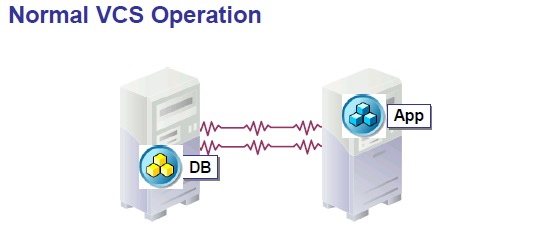In multinode cluster,the I/O fencing algorithm is designed to give priority to larger clusters in any arbitration scenario.For example,if a single node is separated from 8-node cluster due to an interconnect fault,the 7 node should continue to run.The fencing driver uses the concept of a majority cluster.The fencing algorithm determines if the number of nodes remaining in the cluster is greater than or equal to the number of departed nodes.If so the larger cluster is considered a majority cluster.The majority cluster begins racing immediately for control of the coordinator disks on any membership change.
 |
| 1.0 |
| 1.1 |
I/O fencing uses GAB port b for communication.Fencing is started with the vxfenconfig -c command. The fencing driver vxfen is started during system start up using /etc/rc2.d/s97vxfen.
Configuration Files for I/O fencing:
1./etc/vxfenbtab
2./etc/vxfendg
3./etc/vxfenmode
1.Configure coordinator diskgroup using SCSI-3 Persistent Reservations LUNS .(Most of the SAN supports SCSI-3 PR)
2.Set coordinator flag to the diskgroup
#vxdg -g fendg set coordinator=on
3.Fencing Supports DMP for coordinator and data disks.Set policy in /etc/vxfenmode.
Perform the below on each cluster nodes.
# mv /etc/vxfenmode /etc/vxfenmode.previous # cp /etc/vxfen.d/vxfenmode_scis3_dmp /etc/vxfenmode # cat /etc/vxfenmode vxfen_mode=scsi3 scsi3_disk_policy=dmp
4.Deport the diskgroup. “-t” turns off automatic importing when system starts.
# vxdg deport fendg # vxdg -t import fendg # vxdg deport fendg
5.Create /etc/vxfendg on all cluster nodes
# echo "fendg" > /etc/vxfendg
6.Test the diskgroup for I/O fencing compatibility.
Option “-r” will run the test in non-destructive mode.
Arena-Node2#/opt/VRTSvcs/vxfen/bin/vxfentsthdw -r -g fendg
VERITAS vxfentsthdw version 5.1 Solaris
The utility vxfentsthdw works on the two nodes of the cluster.
The utility verifies that the shared storage one intends to use is
configured to support I/O fencing. It issues a series of vxfenadm
commands to setup SCSI-3 registrations on the disk, verifies the
registrations on the disk, and removes the registrations from the disk.
The logfile generated for vxfentsthdw is /var/VRTSvcs/log/vxfen/vxfentsthdw.log.11074
Enter the first node of the cluster:
node1
Enter the second node of the cluster:
node2
********************************************
Testing node1 /dev/vx/rdmp/disk_4s2 node2 /dev/vx/rdmp/disk_7s2
Evaluate the disk before testing ........................ No Pre-existing keys
RegisterIgnoreKeys on disk /dev/vx/rdmp/disk_4s2 from node node1 ....... Passed
Verify registrations for disk /dev/vx/rdmp/disk_4s2 on node node1 ...... Passed
RegisterIgnoreKeys on disk /dev/vx/rdmp/disk_7s2 from node node2 ....... Passed
Verify registrations for disk /dev/vx/rdmp/disk_7s2 on node node2 ...... Passed
Unregister keys on disk /dev/vx/rdmp/disk_4s2 from node node1 .......... Passed
Verify registrations for disk /dev/vx/rdmp/disk_7s2 on node node2 ...... Failed
Unregistration test for disk failed on node node2.
Unregistration from one node is causing unregistration of keys from the other node.
Disk is not SCSI-3 compliant on node node2.
Execute the utility vxfentsthdw again and if failure persists contact
the vendor for support in enabling SCSI-3 persistent reservations
Removing test keys and temporary files, if any...
Note:As the above results,my test is failed due to SCSI-3 PR issue.
# /sbin/vxfen-startup
Node:/etc/vxfentab will be updated whenever fencing driver re-initializes.
8.Close the cluster configuration on all the cluster nodes.
# haconf -dump -makero
9.Perform the offline configuration (i.e modify main.cf using vi editor)
to add “UseFence = SCSI3” line under the bottom of cluster Name
cluster UNIXARENA
UserNames = { admin = “ABCDGFRFSLK.” }
Administrators = { admin }
ClusterAddress = “192.168.2.7″
UseFence = SCSI3
)
10.Stop VCS on all cluster nodes.
# hastop -all
11.Restart VCS on all the cluster nodes.
# hastart
12.Display the fencing membership status
# vxfenadm -d I/O Fencing Cluster Information: ================================ Fencing Protocol Version: 201 Fencing Mode: SCSI3 Fencing SCSI3 Disk Policy: dmp Cluster Members: * 0 (arena1) 1 (arena2) RFSM State Information: node 0 in state 8 (running) node 1 in state 8 (running)
For your information,we can configure I/O fencing using CLI option as well,
./installvcs -fencing
Thank you for reading.
